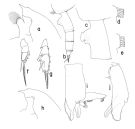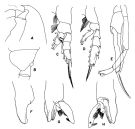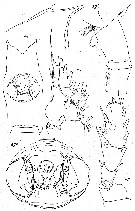|
|
 |
|
Calanoida ( Order ) |
|
|
|
Clausocalanoidea ( Superfamily ) |
|
|
|
Euchaetidae ( Family ) |
|
|
|
Paraeuchaeta ( Genus ) |
|
|
| |
Paraeuchaeta kurilensis Heptner, 1971 (F,M) | |
| | | | | | | Syn.: | Pareuchaeta kurilensis Heptner, 1971 (p.83, Descr.F, figs.F); Mauchline, 1998 (tab.42);
Euchaeta longissima Park, 1978 (p.283, figs.F,M); Ward & Wood, 1988 (p.45, tab.1); Mauchline, 1992 a (p.2); 1994 a (p.561); 1999 (n°182, p.8, figs.F,M);
Paraeuchaeta longissima : Bradford & al., 1983 (p.43, figs.F,M) | | | | Ref.: | | | Bradford & al., 1983 (p.23); Park, 1994 (p.322); 1995 (p.62, Rem.F, M, figs.F,M); Bradford-Grieve & al., 1999 (p.880, 926, figs.F) |  issued from : T. Park in Bull. Scripps Inst. Oceanogr. Univ. California, San Diego, 1995, 29. [p.167, Fig.57]. Female: a, forehead (left side); b, urosome (left); c, genital somite (left); d, outer lobe of Mx1; e, idem (showing variation in size of proximal setae); f, exopod of P1 (anterior); g, exopod of P2 (anterior). Nota: Similar in habitus including rostrum and urosome to P. vorax but can be distinguihed from it by the absence of a conspicuous ridge on the left side of the genital somite. Cephalosomal appendages as in P. gracilicauda and P. vorax with minor exceptions that 1st endopodal segment of Mx1 with 6 setae and outer lobe with 2 small setae proximally, which are somewhat variable in size, in addition to 5 long setae. In P1 exopod, outer spine of 2nd segment reaching base of outer spine of 3rd segment, which is only a little shorter than 1/2 length of terminal spine. In P2 exopod, outer spine of 2nd segment extending to or beyond distal end of following outer spine and about as long as 2nd outer spine of 3rd segment; incision separating 2nd marginal lobe of 3rd segment relatively deep. Male: h, forehead (left); i, distal exopodal segments of left 5th leg (lateral); j, second exopodal segment of left 5th leg (anterior).
|
 issued from : T. Park in Antarctic Res. Ser. Oceanogr. Washington, 1978, 27.[p.284, Fig.121]. As Euchaeta longissima. Female: A, forehead (lateral); B, posterior part of metasome and urosome (dorsal); C, genital segment (ventral); D, posterior part of metasome and urosome (left side, lateral); E, last metasomal and genital segments (right side, lateral); F, outer lobe of Mx1; G, P1; H, P2. P1-2: legs (anterior). Nota from Bradford & al. (1983, p.43): - P1 exopod female: Aa = 1/4 AB; Bb = BC; Cc > BC. - P2 exopod female: Aa = AB + 1/2 Bb; Bb = 1/2 BC; Cc = CD; Dd = 1/6 CD. (see code of lengths outer spines in the Genus' figure, or in Paraeuchaeta sp. A).
|
 issued from : T. Park in Antarctic Res. Ser. Oceanogr. Washington, 1978, 27.[p.285, Fig.122]. As Euchaeta longissima. Male: A, forehead (lateral); B, last metasomal and genital segments (left side); C, P1; D, P2; E, P5; F, serrated lamella of left P5 (anterolateral); G, H, distal part of exopod of left P5 (lateral and medial, respectively). P1-5: legs (anterior). Nota from Bradford & al. (p.43): - P1 exopod male: Aa minute; Bb < 1/2 BC; Cc = 3/4 BC. - P2 exopod male: Aa : 1/4 AB; Bb = 1/3 BC; Cc = 1/3 CD; Dd = 1/5 CD. (see code of lengths outer spines in the Genus' figure, or in Paraeuchaeta sp. A).
|
 issued from : M.V. Heptner in Trudy. Inst. Okeanol., 1971, 92. [p.84, Fig.4]. As Pareuchaeta kurilensis. Female (from Kuril-Kamchatka Trench): r, rostrum, sgf, genital segment (ventral); sgl, idem (lateral); agn, genital area; P1 ; P2. Formula of the exopod of P1 spines on the last two segments, successively : Aa < AB (Aa = 1/2 AB); Bb > BC (Bb = 1 1/6 BC); Cc ≈ 2 BC. Variant: Aa = 2/3 AB. P2 : Aa > AB (Aa = Ab); Bb < BC (Bb = 1/2 BC); Cc < CD (Cc ≈ 5/6 CD). Variant: Aa < AB (Aa = AB + 2/3 Bb); Aa > Ab (Aa = Ab + 1/3 Bb); Bb ≈ 2/3 BC. [cf. legend in drawings of Heptner, 1971, for Pareuchaeta rubra]
|
 issued from : J. Mauchline in ICES Ident. Leafl. Plankton, 1999, N°182. [p.3, Fig.2: 10a]. As Euchaeta longissima. Female (Northeast Atlantic): 10a, genital double-somite (left side).
|
 issued from : J. Mauchline in ICES Ident. Leafl. Plankton, 1999, N°182. [p.4, Fig.3: 10b]. Male (Northeast Atlantic): 10b, terminal two segments, exopodal segments of left P5.
|
 Paraeuchaeta kurilensis Paraeuchaeta kurilensis Female: 1 - See key to species Groups and independent species of Paraeuchaeta (p.30): malayensis species Group. 2 - Outer spine of 2nd exopodal segment (or the 2nd of the first 2 exopodal segments forming a proximal, compound segment) of P1 normally developed (Fig.57-f). 3 - Outer lobe of Mx1 with 5 long setae in addition to some very small setae proximally (Fig.57-d). 4 - Laterally, genital prominence low with more or less convex genital flanges (Fig.57-c). 5 - Laterally, rostrum well developed (Fig.57-a). 6 - Laterally, posterior margin of genital prominence smoothly merging into posterior ventral wall of somite (Fig.57-c). 7 - Genital somite without conspicuously ridged outgrowth on left side posterior to genital prominence (Fig.57-c). 8 - Laterally, rostrum thick, pointing obliquely forward (Fig.57-a).
| | | | | Compl. Ref.: | | | Razouls & al., 2000 (p.343, Appendix); Park & Ferrari, 2009 (p.143, Table 4, Appendix 1) | | | | NZ: | 10 | | |
|
Distribution map of Paraeuchaeta kurilensis by geographical zones
|
| | | | | | | | | | Loc: | | | Antarct.: South Georgia, SE Atlant., Pacif. (SW, S & SE); Atlant. (NE & SE), off Rockall Is., W Indian, Japan, Kuril-Kamchatka, Tasman Sea, Pacif. (E & central N) | | | | N: | 6 | | | | Lg.: | | | (3) F: 7,9-5,83; M: 6,9-5,91; (20) F: 7,91-7,25; M: 6,5; (23) F: 8,35-8; {F: 5,83-8,35; M: 5,91-6,90} | | | | Rem.: | Meso-bathypelagic (1900-4000 m).
Sampling depth (Antarct.) : 0-1000+ m.
For Park (1995, p.62) the female is similar in habitus including rostrum and urosome to P. vorax but can be distinguished from it by the absence of a conspicuous ridge on the left side of the genital somite. In form of genital somite, this species resembling closely P. gracilicauda but distinctly different from it in form of rostrum, which is relatively short and thick (very elongated in P. gracilicauda). Ventral margin of genital flange more convex than in either P. vorax or P. gracilicauda.
Park (1995, p.63) found the species, which are identical with those previously described as Euchaeta longissima from the antarctic zone of the Pacific (Park, 1978, p.283) are smaller than, and slightly different in some morphological detyails from Hepner's original specimens (one of which was reexamined in the study). The main differences include the shape of the genital flange, which in Hepner's specimens has a ventral margin tilted more forward than in the Park's specimens,and the 1st outer spine of the P1 exopod, which reaches halfway to the base of the following spine in Heptner's specimens, while it is very small in Park's specimens.
Park (1995, p.63) found this species in the Pacific sector of the Antarctic at 76°S, 160°W, in the northeastern Atlantic between 47°N and 49°N, the eastern South Atlantic at 32°S, the central South Atlantic at 10°S, in the eastern tropical Pacific off Central America at 13°N and 15°N, the central North Pacific at 31°N, off the Pacific coast of Japan at 33°N and 35°N,, the Tasman Sea at 47°S, and the western Indian Ocean at 35°S. | | | Last update : 27/02/2015 | |
|
|
 Any use of this site for a publication will be mentioned with the following reference : Any use of this site for a publication will be mentioned with the following reference :
Razouls C., Desreumaux N., Kouwenberg J. and de Bovée F., 2005-2025. - Biodiversity of Marine Planktonic Copepods (morphology, geographical distribution and biological data). Sorbonne University, CNRS. Available at http://copepodes.obs-banyuls.fr/en [Accessed December 30, 2025] © copyright 2005-2025 Sorbonne University, CNRS
|
|
 |
 |









